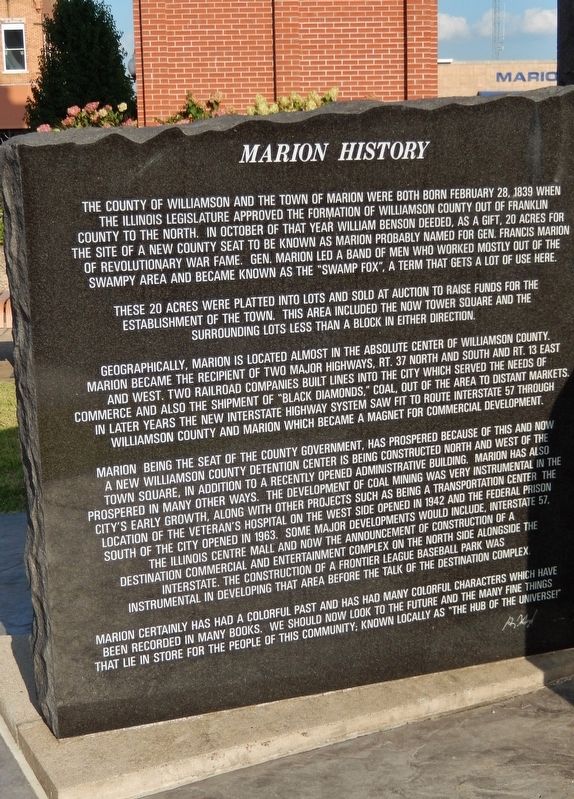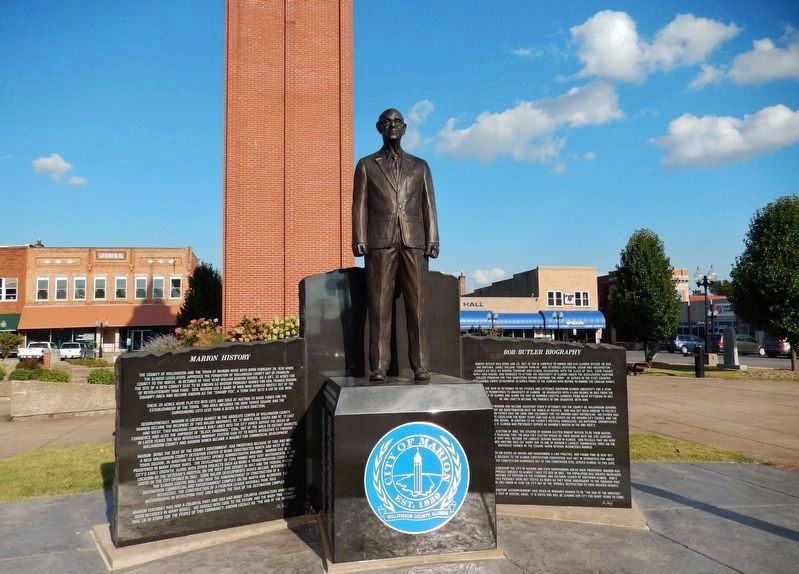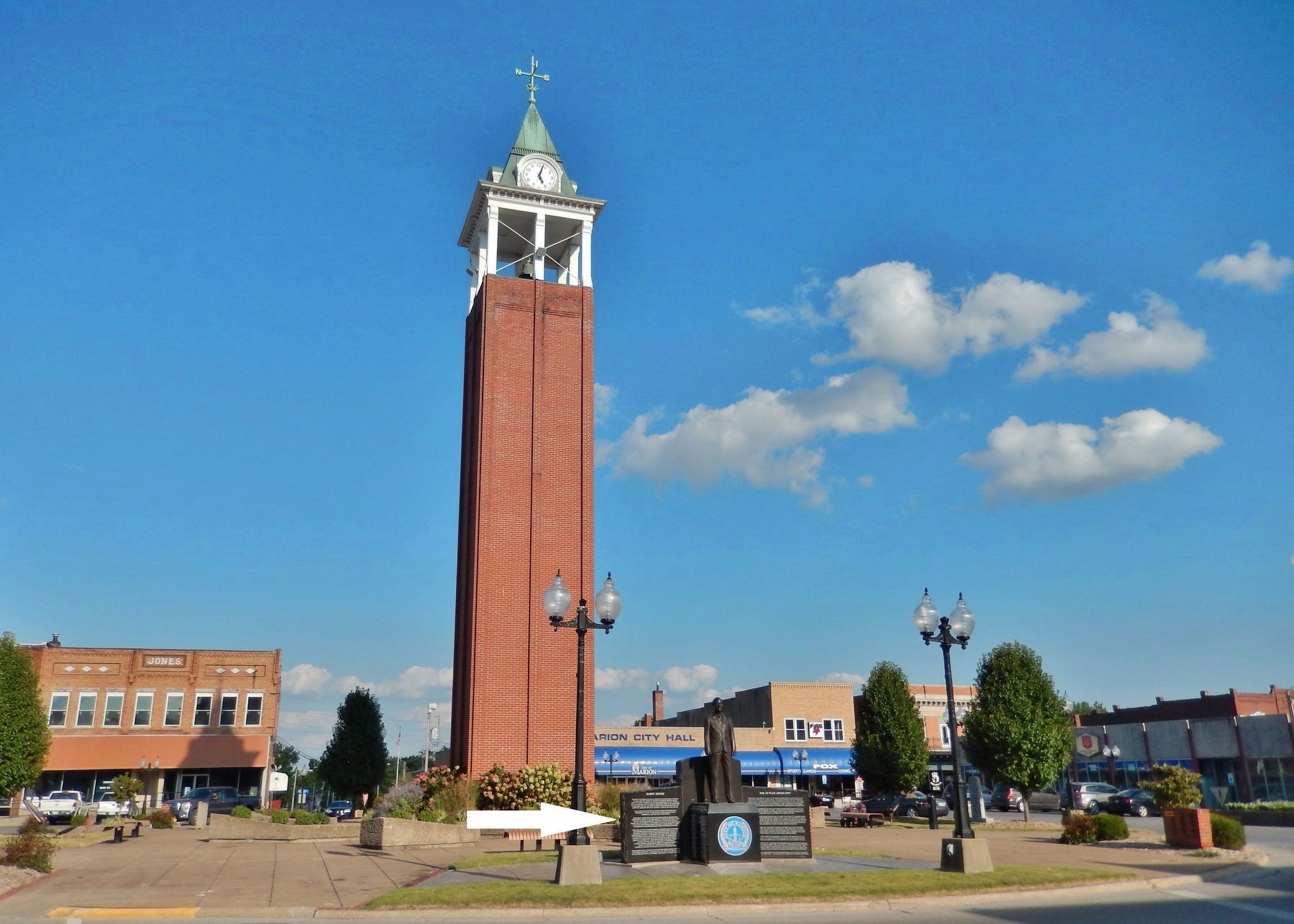Marion in Williamson County, Illinois — The American Midwest (Great Lakes)
Marion History
The county of Williamson and the town of Marion were both born February 28, 1839 when the Illinois Legislature approved the formation of Williamson County out of Franklin County to the north. In October of that year William Benson deeded, as a gift, 20 acres for the site of a new county seat to be known as Marion probably named for Gen. Francis Marion of Revolutionary War fame. Gen. Marion led a band of men who worked mostly out of the swampy area and became known as the “Swamp Fox,” a term that gets a lot of use here.
These 20 acres were platted into lots and sold at auction to raise funds for the establishment of the town. This area included the now Tower Square and the surrounding lots less than a block in either direction.
Geographically, Marion is located almost in the absolute center of Williamson County. Marion became the recipient of two major highways, Rt. 37 north and south and Rt. 13 east and west. Two railroad companies built lines into the city which served the needs of commerce and also the shipment of “black diamonds,” coal, out of the area to distant markets. In later years the new interstate highway system saw fit to route Interstate 57 through Williamson County and Marion which became a magnet for commercial development.
Marion being the seat of the country government, has prospered because of this and now a new Williamson County Detention Center is being constructed north and west of the town square, in addition to a recently opened administrative building. Marion has also prospered in many other ways. The development of coal mining was very instrumental in the city’s early growth, along with other projects such as being a transportation center. The location of the Veteran’s Hospital on the west side opened in 1942 and the Federal Prison south of the city opened in 1963. Some major developments would include, Interstate 57, the Illinois Centre Mall and now the announcement of construction of a destination commercial and entertainment complex on the north side alongside the interstate. The construction of a Frontier League baseball park was instrumental in developing that area before the talk of the destination complex.
Marion certainly has had a colorful past and has had many colorful characters which have been recorded in many books. We should now look to the future and the many fine things that lie in store for the people of this community; known locally as “The Hub of the Universe!”
Topics. This historical marker is listed in these topic lists: Industry & Commerce • Railroads & Streetcars • Roads & Vehicles • Settlements & Settlers. A significant historical date for this entry is February 28, 1839.
Location. 37° 43.849′
N, 88° 55.642′ W. Marker is in Marion, Illinois, in Williamson County. Marker is at the intersection of Tower Square Plaza and West Main Street, in the median on Tower Square Plaza. Marker is located near the clock tower in Tower Square Plaza, facing west toward West Main Street. Touch for map. Marker is at or near this postal address: 1102 Tower Square Plaza, Marion IL 62959, United States of America. Touch for directions.
Other nearby markers. At least 8 other markers are within 8 miles of this marker, measured as the crow flies. Bob Butler Biography (here, next to this marker); John A. Logan Speech (a few steps from this marker); I Shall Stand For This Union (a few steps from this marker); Marion Tornado Memorial (within shouting distance of this marker); Cross Roads School (approx. 3.4 miles away); Herrin Massacre Memorial (approx. 6.1 miles away); George Rogers Clark (approx. 7.1 miles away); War Memorial (approx. 7.6 miles away). Touch for a list and map of all markers in Marion.
More about this marker. Marker is the left-hand (north) end of a large granite monument which includes a sculpture of former Marion Mayor Robert Butler in the center and a related historical marker about him on the right (south) end.
Also see . . .
1. Marion and Eastern Railroad, Marion, Illinois. The line was originally built in 1908 and was a short line railroad of 11.5 miles extending from Marion, Illinois to Paulton, Illinois. Approximately 97 percent of its freight
consisted of coal supplied by five mines having an aggregate daily rating of from 99 to 107 cars. The average haul for the coal was about 8.1 miles but the line did also transport some freight and passengers. Most of the passengers were likely miners coming an going to work.
The short line railroad which had once run three trains a day each way between Marion and Paulton, hauling approximately 6000 tons of coal from the Franco mines that employed about 600 men, at the end, operated at a deficit.
The old Marion and Eastern tracks are still on the road bed of the short line which ran from a junction of the Illinois Central near Old Route 13 east of the fair grounds to Pittsburg and the mine fields. (Submitted on July 2, 2018, by Cosmos Mariner of Cape Canaveral, Florida.)
2. Elusive and crafty, Francis Marion outwitted British troops during the American Revolution. Smithsonian Magazine entry:
In November of 1780, Marion earned the nickname he’s remembered by today. British Lieutenant Colonel Banastre Tarleton, informed of Marion’s whereabouts by an escaped prisoner, chased the American militia for seven hours, covering some 26 miles. Marion escaped into a swamp, and Tarleton gave up, cursing, “As for this damned old fox, the Devil himself could not catch him.” The story got around, and soon the locals—who loathed the British occupation—were cheering the Swamp Fox. (Submitted on July 2, 2018, by Cosmos Mariner of Cape Canaveral, Florida.)
Credits. This page was last revised on July 10, 2022. It was originally submitted on July 2, 2018, by Cosmos Mariner of Cape Canaveral, Florida. This page has been viewed 350 times since then and 23 times this year. Photos: 1, 2, 3. submitted on July 2, 2018, by Cosmos Mariner of Cape Canaveral, Florida. • Andrew Ruppenstein was the editor who published this page.


